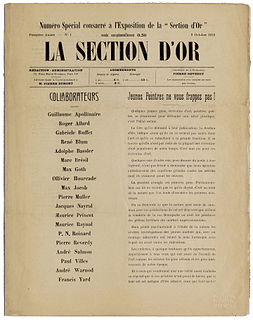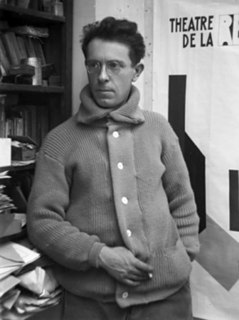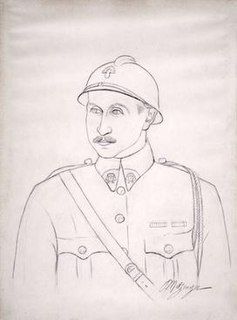
Jean Dominique Antony Metzinger was a major 20th-century French painter, theorist, writer, critic and poet, who along with Albert Gleizes wrote the first theoretical work on Cubism. His earliest works, from 1900 to 1904, were influenced by the Neo-impressionism of Georges Seurat and Henri-Edmond Cross. Between 1904 and 1907 Metzinger worked in the Divisionist and Fauvist styles with a strong Cézannian component, leading to some of the first proto-Cubist works.

Albert Gleizes was a French artist, theoretician, philosopher, a self-proclaimed founder of Cubism and an influence on the School of Paris. Albert Gleizes and Jean Metzinger wrote the first major treatise on Cubism, Du "Cubisme", 1912. Gleizes was a founding member of the Section d'Or group of artists. He was also a member of Der Sturm, and his many theoretical writings were originally most appreciated in Germany, where especially at the Bauhaus his ideas were given thoughtful consideration. Gleizes spent four crucial years in New York, and played an important role in making America aware of modern art. He was a member of the Society of Independent Artists, founder of the Ernest-Renan Association, and both a founder and participant in the Abbaye de Créteil. Gleizes exhibited regularly at Léonce Rosenberg’s Galerie de l’Effort Moderne in Paris; he was also a founder, organizer and director of Abstraction-Création. From the mid-1920s to the late 1930s much of his energy went into writing, e.g., La Peinture et ses lois, Vers une conscience plastique: La Forme et l’histoire and Homocentrisme.

The Section d'Or, also known as Groupe de Puteaux, was a collective of painters, sculptors, poets and critics associated with Cubism and Orphism. Based in the Parisian suburbs, the group held regular meetings at the home of the Duchamp brothers in Puteaux and at the studio of Albert Gleizes in Courbevoie. Active from 1911 to around 1914, members of the collective came to prominence in the wake of their controversial showing at the Salon des Indépendants in the spring of 1911. This showing by Albert Gleizes, Jean Metzinger, Robert Delaunay, Henri le Fauconnier, Fernand Léger and Marie Laurencin, created a scandal that brought Cubism to the attention of the general public for the first time.

André Salmon was a French poet, art critic and writer. He was one of the early defenders of Cubism, with Guillaume Apollinaire and Maurice Raynal.

Maurice Princet was a French mathematician and actuary who played a role in the birth of cubism. He was an associate of Pablo Picasso, Guillaume Apollinaire, Max Jacob, Jean Metzinger, and Marcel Duchamp. He is known as "le mathématicien du cubisme".

Joseph Csaky was a Hungarian avant-garde artist, sculptor, and graphic artist, best known for his early participation as a sculptor in the Cubist movement. Joseph Csaky was one of the first sculptors in Paris to apply the principles of pictorial Cubism to his art. A pioneer of modern sculpture, Csaky is among the most important sculptors of the early 20th century. He was an active member of the Section d'Or group between 1911 and 1914, and closely associated with Crystal Cubism, Purism, De Stijl, Abstract art, and Art Deco throughout the 1920s and 1930s.

Le Goûter, also known as Tea Time (Tea-Time), and Femme à la Cuillère is an oil painting created in 1911 by the French artist and theorist Jean Metzinger (1883–1956). It was exhibited in Paris at the Salon d'Automne of 1911, and the Salon de la Section d'Or, 1912.

Léonce Rosenberg was an art historian, art collector, publisher and one of the most influential French art dealers of the 20th century. The son of an antique dealer Alexander Rosenberg and brother of the gallery owner Paul Rosenberg, Léonce, a prominent gallery owner in Paris at the end of World War I, would become one of the world's major dealers of Modern art.

La Femme aux Phlox, also known as Woman with Phlox or Woman with Flowers, is an oil painting created in 1910 by the French artist and theorist Albert Gleizes (1881–1953). The painting was exhibited in Room 41 at the Salon des Indépendants in the Spring of 1911 ; the exhibition that introduced Cubism as a group manifestation to the general public for the first time. The complex collection of geometric masses in restrained colors exhibited in Room 41 created a scandal from which Cubism spread throughout Paris, France, Europe and the rest of the world. It was from the preview of the works by Gleizes, Metzinger, Le Fauconnier, Delaunay and Léger at the 1911 Indépendants that the term 'Cubism' can be dated. La Femme aux Phlox was again exhibited the following year at the Salon de la Section d'Or, Galerie La Boétie, 1912. La Femme aux Phlox was reproduced in The Cubist Painters, Aesthetic Meditations by Guillaume Apollinaire, published in 1913. The same year, the painting was again revealed to the general public, this time in the United States, at the International Exhibition of Modern Art, New York, Chicago, and Boston. The work is now in the Museum of Fine Arts, Houston, Gift of the Esther Florence Whinery Goodrich Foundation in 1965.

L'Arbre , is a painting created in 1910 by the French artist, theorist and writer Albert Gleizes. Executed in an advanced Proto-Cubist style, the work was exhibited in Paris at the Salon des Indépendants, 1910, the following year Gleizes chose to exhibit this work at the Salon de la Section d'Or, Galerie La Boétie, 1912, and Manes Moderni Umeni, S.V.U., Vystava, Prague, 1914. The painting was again shown at the Grand Palais, Salon des Indépendants, Trente ans d'art indépendant, in 1926. L'Arbre, an important work of 1910, appeared at the decisive Salon des Indépendants of 1911, where Cubism emerged as a group manifestation and spread across the globe, at times shocking the general public.

L'Homme au hamac, also referred to as Man in a Hammock, is a painting created in 1913 by the French artist, theorist and writer Albert Gleizes. The work was exhibited at Moderni Umeni, SVU Mánes, Vystava, Prague, February – March 1914, no. 41; and Der Sturm, Berlin, July – August 1914. The painting was reproduced in Guillaume Apollinaire, Paris-Journal, July 4, 1914 ; and Albert Gleizes, L'Épopée, Le Rouge et le Noir, October 1929, p. 81. Stylistically Gleizes' painting exemplifies the principle of mobile perspective laid out in Du "Cubisme", written by himself and French painter Jean Metzinger. Evidence suggests that the man reclining in the hammock is indeed Jean Metzinger. Formerly in the collection of Metzinger, the first owner of the painting, Man in a Hammock forms part of the permanent collection of the Albright-Knox Art Gallery, Buffalo, New York.

The Société Normande de Peinture Moderne, also known as Société de Peinture Moderne, or alternatively, Normand Society of Modern Painting, was a collective of eminent painters, sculptors, poets, musicians and critics associated with Post-Impressionism, Fauvism, Cubism and Orphism. The Société Normande de la Peinture Moderne was a diverse collection of avant-garde artists; in part a subgrouping of the Cubist movement, evolving alongside the so-called Salon Cubist group, first independently then in tandem with the core group of Cubists that emerged at the Salon d'Automne and Salon des Indépendants between 1909 and 1911. Historically, the two groups merged in 1912, at the Section d'Or exhibition, but documents from the period prior to 1912 indicate the merging occurred earlier and in a more convoluted manner.
Didier Ottinger, born in Nancy in 1957, is a museum curator, art critic and French author. He is known for organizing exhibitions and publishing books on modern and contemporary painting. He is now assistant director of Centre national d'art et de culture Georges-Pompidou, Musée national d'art moderne, Paris.

Les Peintres Cubistes, Méditations Esthétiques, is a book written by Guillaume Apollinaire between 1905 and 1912, published in 1913. This was the third major text on Cubism; following Du "Cubisme" by Albert Gleizes and Jean Metzinger (1912); and André Salmon, Histoire anecdotique du cubisme (1912).

Soldier at a Game of Chess, is a painting by the French artist Jean Metzinger. While serving as a medical orderly during World War I in Sainte-Menehould, France, Metzinger bore witness to the ravages of war firsthand. Rather than depicting such horrors, Metzinger chose to represent a poilu sitting at a game of chess, smoking a cigarette. The military subject of this painting is possibly a self-portrait.

Crystal Cubism is a distilled form of Cubism consistent with a shift, between 1915 and 1916, towards a strong emphasis on flat surface activity and large overlapping geometric planes. The primacy of the underlying geometric structure, rooted in the abstract, controls practically all of the elements of the artwork.

Portrait of an Army Doctor is a 1914-15 painting by the French artist, theorist and writer Albert Gleizes. Painted at the fortress city of Toul (Lorraine) while Gleizes served in the military during the First World War, the paintings abstract circular rhythms and intersecting aslant planes announce the beginning of the second synthetic phase of Cubism. The work represents Gleizes's commanding officer, Major Mayer-Simon Lambert (1870-1943), the regimental surgeon in charge of the military hospital at Toul. At least eight preparatory sketches, gouaches and watercolors of the work have survived, though Portrait of an Army Doctor is one of the only major oil paintings of the period.

Woman with Black Glove is a painting by the French artist, theorist and writer Albert Gleizes. Painted in 1920, after returning to Paris in the wake of World War I, the paintings highly abstract structure is consistent with style of experimentation that transpired during the second synthetic phase of Cubism, called Crystal Cubism. As other post-wartime works by Gleizes, Woman with Black Glove represents a break from the first phase of Cubism, with emphasis placed on flat surface activity and large overlapping geometric planes.



















